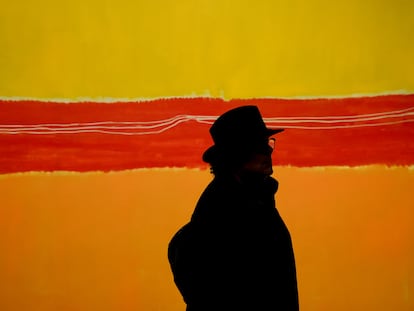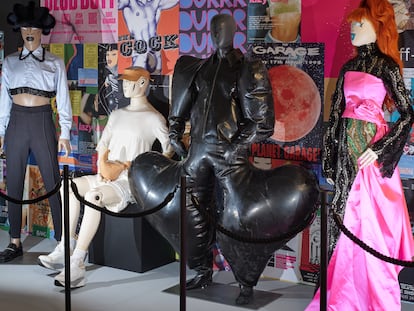Paris and London face each other in the war of art
The two cities aspire to become the capital of the sector in Europe. London remains dominant despite the burden of Brexit, but Paris is favored by its new private museums and by the arrival of Art Basel, which has created a new fair in the city
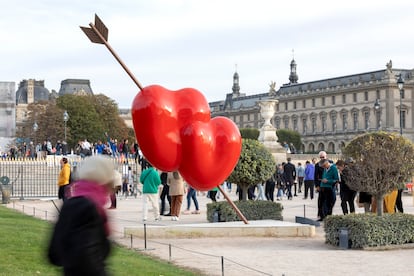

Paris and London are facing off against each other once again. The historic rivalry between France and England has recently turned into a battle to be Europe’s art capital. Throughout the month of October, the two cities have jockeyed for position as they hosted two of the biggest art fairs in the world: Frieze, the longstanding London event that just celebrated its 20th anniversary, and Paris+, promoted in the French capital by the Swiss giant Art Basel, which closed its second fair last Sunday. The outcome of the contest is unclear. There are those who assert London’s continued dominance, a claim the numbers support. Others observe the two cities’ peaceful status as co-capitals. And still others predict a gradual shift of the center of gravity toward Paris, which the city’s symbolic capital of desirability favors: The New York Times just designated it “the new darling” of the art world. “Paris+ is like a new puppy,” confirms Olivier Babin, a gallerist at Clearing, which has offices in New York, Los Angeles and Brussels. And who doesn’t like puppies?
Several factors explain this shift in the art world. The first is undoubtedly Brexit, not only because of the erosion of London’s international aura with the move’s isolationist reflex, but also because of a purely financial issue. By leaving the common market, art purchases made in London by collectors or European institutions are penalized by tariffs of between 5% and 20%, which has recently caused the largest galleries to open headquarters in Paris. The first was David Zwirner, the most important gallerist in the world according to the 2023 Power100 list, followed by the very London-based White Cube and the New York-based Skarstedt and LGDR. The all-powerful Hauser & Wirth is the latest arrival; it just opened its 17th gallery in an elegant mansion on Paris’s rive droite.
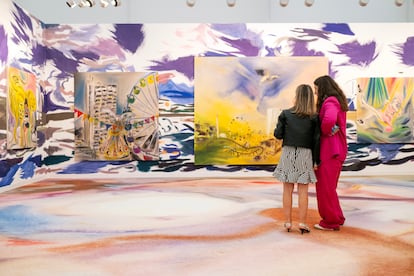
Regent’s Park, Oct. 11. London Mayor Sadiq Khan, actors like Andrew Garfield, Emily Blunt and Florence Pugh, and musicians such as Neil Tennant, Jarvis Cocker and FKA Twigs wandered through the Frieze London exhibits at the inaugural VIP collectors’ session. The fair’s first edition in 2003, which was riskier and more hooligan, was held in the same place, albeit in a more modest tent. At that time, London art was experiencing a high point on the heels of the creation of Tate Modern and amid the rise of the Young British Artists. “Everything has changed a lot. The city’s art world was very small then, whereas now London is a global capital that welcomes new demographics that were [previously] excluded because of their gender, race and geography,” says the fair’s director, Eva Langret. “The rivalry with Paris doesn’t worry me. London is still dominant, but I don’t think you have to choose one or the other.” Langret benefits from a certain equidistance: she is French.
In 2022, the first edition of Paris+, backed by Art Basel’s nearly absolute power, put London to shame. This year, the British capital has pulled out all the stops. Despite the excessive dominance of painting and an irrepressible inclination toward the commercial, this may have been the best version in years. The opening included some of the great exhibitions of 2023, such as the one that the Royal Academy dedicated to Marina Abramovic, the icon of pop performance, and the one at the Tate Modern featuring Philip Guston, who is known for his controversial paintings of the Ku Klux Klan. “London has brought out its claws. It’s important to have healthy competition. Both cities have the ability to be capitals at the same time. Paris is rising, but London is still London,” Italian collector Patrizia Sandretto opined, as she passed by in a hallway. Maisterra Valbuena, one of the four Spanish galleries exhibiting at Frieze, agreed with Sandretto’s assessment. “I don’t see a decline. Their visual culture is just as powerful. For us, contact with the Parisian market is more difficult. We are less comfortable,” said co-director, Pedro Maisterra.
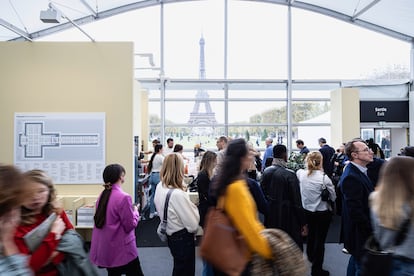
Grand Palais Ephémère, October 18. Paris+ opened its doors in a temporary tent pitched in front of the Eiffel Tower, as it waits for the work for its official venue, the centennial Grand Palais, to be completed in 2024. An absurd sense of euphoria was in the air in the French capital, just days after the start of the Israel-Hamas conflict, even as the terror alert was at its highest level and the bedbug panic was in full swing. “Paris+ reflects the city’s cultural effervescence, its dynamism and its attractiveness,” its director, Clément Delépine, declared. And, in a revealing slip of the tongue, he added that Paris already accounts for “the majority of art transactions in Europe, 54% of the entire continent,” a figure that would only be correct if the United Kingdom were left out. “I mean the European Union,” he immediately corrected himself. That semantic confusion is taking hold: some professionals consulted —especially Americans, who have gathered in the French capital, with which they have long had a romance— equated Paris with Europe, as if the United Kingdom no longer belonged to the continent.
“London has brought out its claws. It’s important to have healthy competition. Both cities have the capacity to be capitals at the same time,” says collector Patrizia Sandretto.
On the first day of the fair, Zwirner sold a painting by Kerry James Marshall for €5.7 million ($6,053,827), the best sale of the month, followed by Alice Neel and Marlene Dumas works for about €3 million ($3,186,225). For its part, before its new gallery in Paris opened, Hauser & Wirth sold all 30 paintings in the exhibition featuring Henry Taylor, an artist from the ranks of the new African American figuration movement (he has been praised by Barack Obama and Kendrick Lamar).
“The war between the two cities is taking place, but mostly in the media,” Marc Payot, the co-president of Hauser & Wirth, says ironically. “London has seen better days, for political and economic reasons, but it remains a major cultural force. On the other hand, Paris, a city of undisputed historical importance since the days of the avant-garde, has been enhanced by its new museums and foundations.” He is referring to artistic projects linked to Paris’s ever-omnipresent luxury sector, such as Bernard Arnault’s LVMH Foundation (which just opened a historic exhibition dedicated to Rothko), François Pinault’s Bourse de Commerce and the new headquarters that Cartier will open next to the Louvre, which have turned the heart of cultural protectionism into a new paradise for private initiative. Paradoxically, in ultra-liberal London, public museums such as the two Tate museums and the National Gallery have the upper hand.

Despite the perception that Paris is gaining ground, London continues to prevail in the battle of the numbers, which are stubborn. The Art Basel and UBS annual report, a benchmark in the sector, indicates that the French market accounts for 7% of global art trade transactions, a far cry from the United Kingdom’s 18%, despite signs of an incipient erosion and the imminent danger of inflation. Another indicator is that auction houses, which used to be concentrated in the British capital, are also starting to look to Paris.
A few days ago, an auction at the Paris headquarters of Christie’s—which was founded by the British but is currently owned by the French Pinault—sold a work by Miró for €20.7 million ($21,980,295), one of the highest sales of the season. Until recently, such stratospheric bids used to take place in London. The situation has changed: in 2022, Sotheby’s organized 70 auctions in Paris, 140% more than just a decade ago. A sculpture at Frieze encapsulates what increasingly seems to be the situation in the British capital: Flo (2022), by the duo Elmgreen & Dragset, depicts a grief-stricken child, tears welling up in his eyes, despite the fact that he’s holding a gigantic trophy in his hands.
Sign up for our weekly newsletter to get more English-language news coverage from EL PAÍS USA Edition
Tu suscripción se está usando en otro dispositivo
¿Quieres añadir otro usuario a tu suscripción?
Si continúas leyendo en este dispositivo, no se podrá leer en el otro.
FlechaTu suscripción se está usando en otro dispositivo y solo puedes acceder a EL PAÍS desde un dispositivo a la vez.
Si quieres compartir tu cuenta, cambia tu suscripción a la modalidad Premium, así podrás añadir otro usuario. Cada uno accederá con su propia cuenta de email, lo que os permitirá personalizar vuestra experiencia en EL PAÍS.
¿Tienes una suscripción de empresa? Accede aquí para contratar más cuentas.
En el caso de no saber quién está usando tu cuenta, te recomendamos cambiar tu contraseña aquí.
Si decides continuar compartiendo tu cuenta, este mensaje se mostrará en tu dispositivo y en el de la otra persona que está usando tu cuenta de forma indefinida, afectando a tu experiencia de lectura. Puedes consultar aquí los términos y condiciones de la suscripción digital.
More information
Archived In
Últimas noticias
Most viewed
- Oona Chaplin: ‘I told James Cameron that I was living in a treehouse and starting a permaculture project with a friend’
- Reinhard Genzel, Nobel laureate in physics: ‘One-minute videos will never give you the truth’
- Sinaloa Cartel war is taking its toll on Los Chapitos
- Why the price of coffee has skyrocketed: from Brazilian plantations to specialty coffee houses
- Silver prices are going crazy: This is what’s fueling the rally
